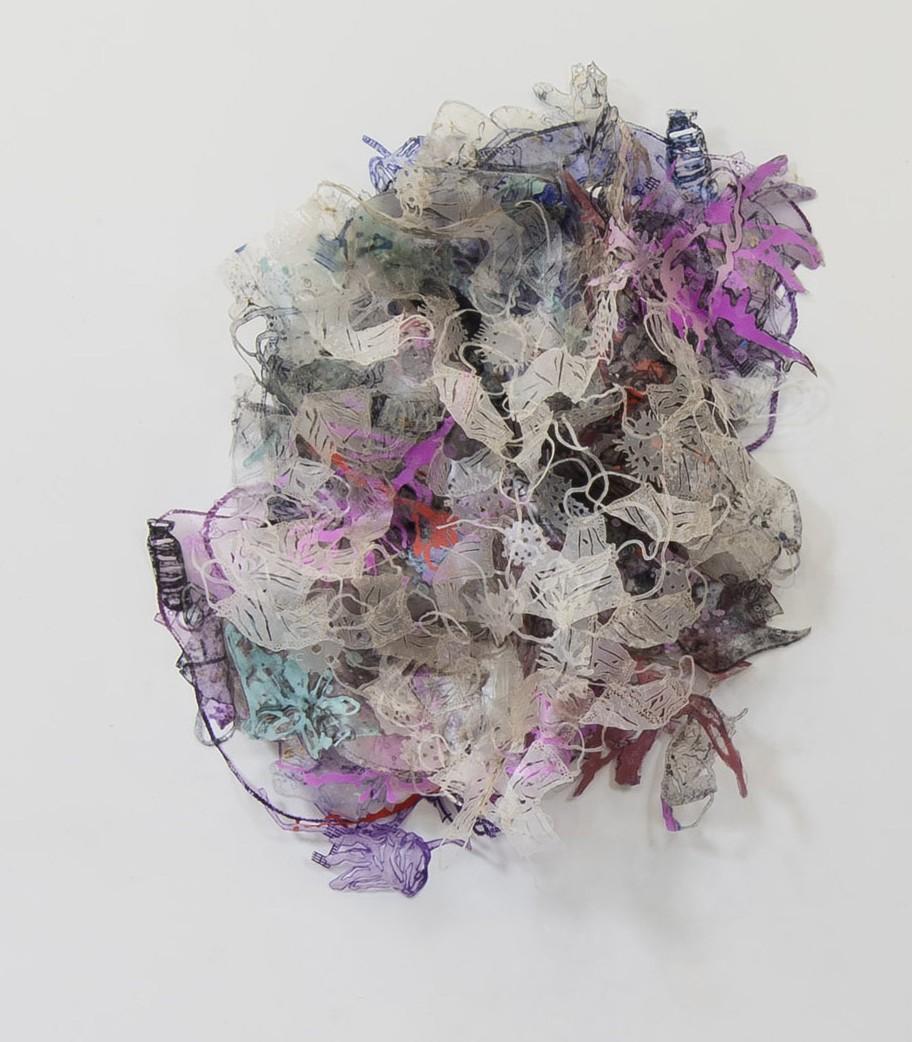




2022 was Childs Gallery’s second year at our 168 Newbury Street location. In this new space, we held thirteen exhibitions –seven on our main floor and six in our upstairs print department – spanning a myriad of different media and styles, carrying on a longstanding gallery tradition of showing both historical artworks and contemporary pieces. In this way, we continue to honor the gallery’s past while looking towards its future.
With solo exhibitions we welcomed artists new to our space including Jorge R. Pombo and Robert Freeman, in addition to showcasing returning favorites such as Sean Flood, Emily Lombardo, and Robert S. Neuman. Group shows highlighted the various printmaking processes, objet d’art from the era of the Grand Tour, and animal imagery from the 19th century to the present.
We hope you enjoy our Exhibition Highlights from this past year and welcome all inquiries regarding the shows and artworks therein.* We look forward to seeing you at the gallery in 2023 for more exciting, inspiring exhibitions at Childs.
Front cover: Robert Freeman, American (b. 1946). American Regatta (detail), 2021. Oil on canvas, 72 x 52 inches. $30,000.
Back cover: Joan Hall, American. Touches Me, 2022. Handmade paper, pulp painting, collagraph, acrylic, mylar, hand-cut construction, 45 x 42 x 15 inches. $12,000.
*Prices are subject to change without notice. Please inquire for full cataloguing and condition description.
Sean Flood, American (b. 1982) Scouting with Kevin, 2016-19 Oil on canvas, 72 x 60 inches

Signed lower right: “Flood”. Titled, dated, and signed verso.
$26,000.
Jorge R. Pombo: Variations on Sargent’s Daughters…………………….…......5
Ink, Press, Repeat: A Survey of Printmaking Techniques................................8
Robert Freeman: America’s Past-time…………………………….….…….......10
Souvenirs of the Grand Tour…...…………………………...…………..…….....12
Sean Flood: Urban Aesthetic………………………………………………….....14
Adam Van Doren: In the Founders’ Footsteps………………………...............16
Resa Blatman – Pure Love: Stardust, Clouds, and Dandelions……...….…..17
Emily Lombardo: Soft Butch Blues.................................................................20
Beauty in the Beasts: Animals in Art…………………………………….….…...22
Robert S. Neuman: Works on Paper……………………………...………...…..24
Joan Hall – Where Sunlight Dances: On the Ocean and In My Memories….........….26
William Evertson: Politics, Protest, History and Myth…….... ....…………...…28
Legendary Diva: Margaret Rose Vendryes Memorial Exhibition…….........…30
Jorge R. Pombo, Spanish (b. 1973)
Variation on Singer Sargent’s ‘The Daughters of Edward Darley Boit (10)’, 2020 Oil on linen, 51 1/8 x 43 1/4 inches
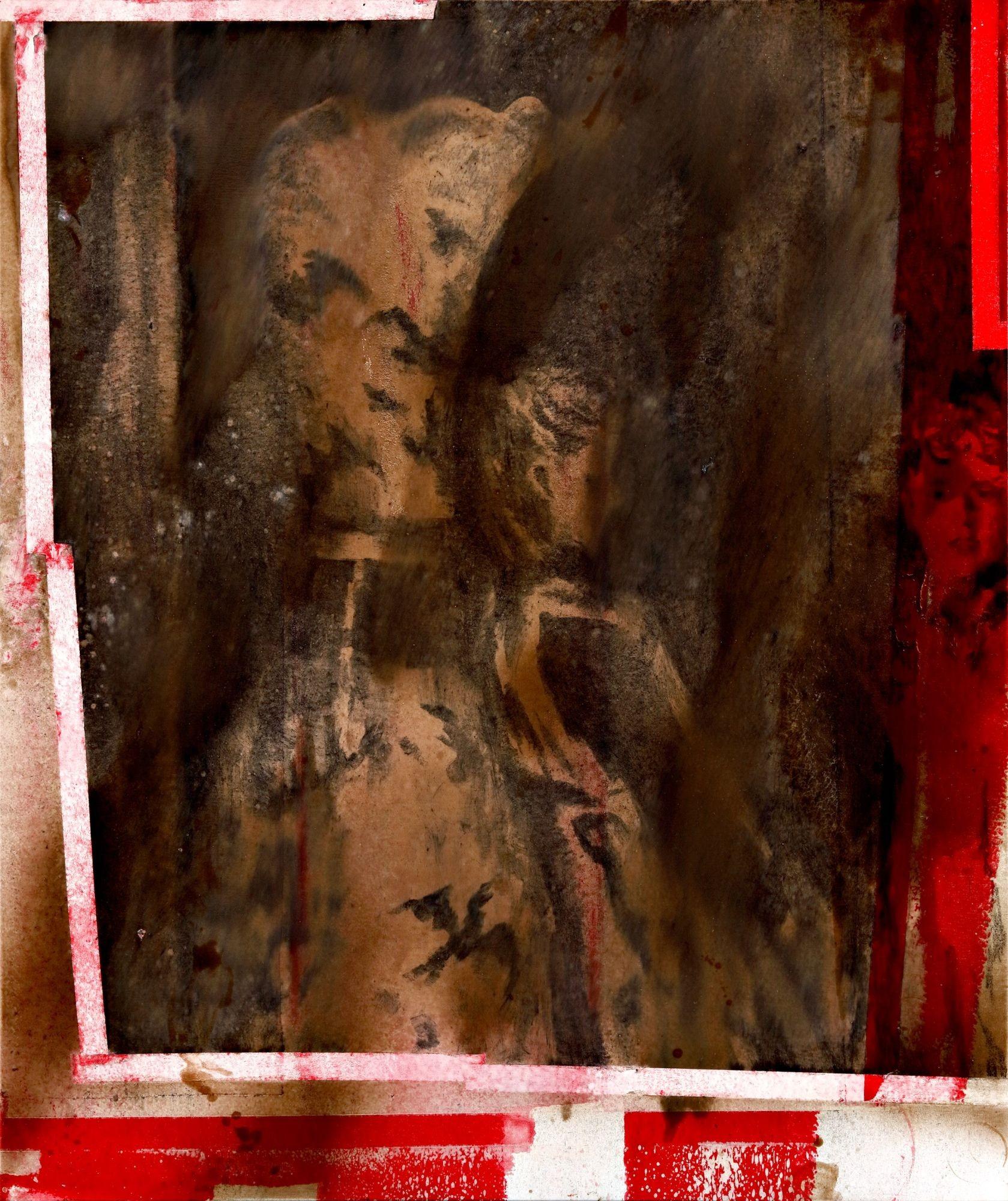
Signed and dated verso: "Jorge R. Pombo / 20-6/1”. Titled verso.
$11,000.
John Singer Sargent’s The Daughters of Edward Darley Boit is half portrait, half interior scene, depicting the four young daughters of Edward Darley Boit and Mary Louisa Cushing Boit in the foyer of their Parisian apartment. Upon its debut in 1882, critics praised the artist’s technical abilities but were perplexed by the unconventional approach to portraiture. The painting’s singular composition positions the figures of the four Boit girls on the threshold of a dark central void, obscuring the features of the two eldest girls. The ambiguous nature of the painting, both beautiful and mysterious, has continued to delight and confound audiences ever since.
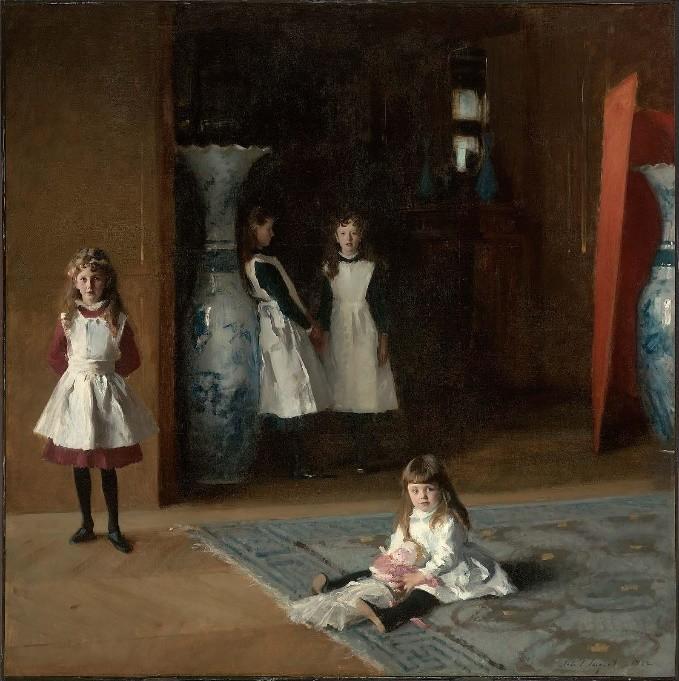
Sargent’s painting is the inspiration for Spanish artist Jorge R. Pombo’s latest series of paintings, Variations on Sargent’s Daughters. Pombo’s striking Variations reinterpret the historical painting, obscuring figure and form through fluid abstraction. Pombo describes his process as one of both affirmation and erasure. Appropriating images from master artists like Tintoretto, Michelangelo, and, of course, Sargent, Pombo renders his chosen image on canvas and then pours solvent over the oils. This method, reminiscent of mid-twentieth century action paintings, produces a fluid, abstracted version of the original masterpiece – a blurred variation emphasizing color and movement rather than figure and form.
Pombo’s fascination with Sargent’s Daughters began during a 2014 trip to the Museum of Fine Arts, Boston. Immediately entranced, the work has held an inexplicably powerful magnetism over him ever since. In early 2020, living in imposed isolation in northern Italy during the Covid-19 pandemic, Pombo decided to finally approach his own interpretations of Sargent’s Daughters. Confronted with the uncertainties of a global health crisis, Sargent’s enigmatic painting proved especially relevant. The painting’s dark central void took on an unnerving nature, becoming a threshold towards something unpredictable and unsettling. Pombo’s resulting Variations emphasize this dark void, a visual representation of the isolation and uneasiness experienced during the pandemic.
Variations on Sargent’s Daughters was Pombo’s first solo exhibition at Childs Gallery, though the artist has exhibited extensively internationally including solo and group shows in China, Italy, Germany, Spain, Switzerland, and the UK. His exhibition venues include the WallrafRichartz Museum in Cologne, the Museo del Duomo di Milan, and the Scuola Grande di San Rocco in Venice.
John Singer Sargent (American, 1856-1925), The Daughters of Edward Darley Boit, 1882, Oil on canvas, 87 3/8 x 87 5/8 inches. Image courtesy of the Museum of Fine Arts, Boston.Jorge R. Pombo, Spanish (b. 1973)
Variation on Singer Sargent's 'The Daughters of Edward Darley Boit’ (7), 2020 Oil on linen with old Venetian fabrics 31 7/8 x 25 1/2 inches
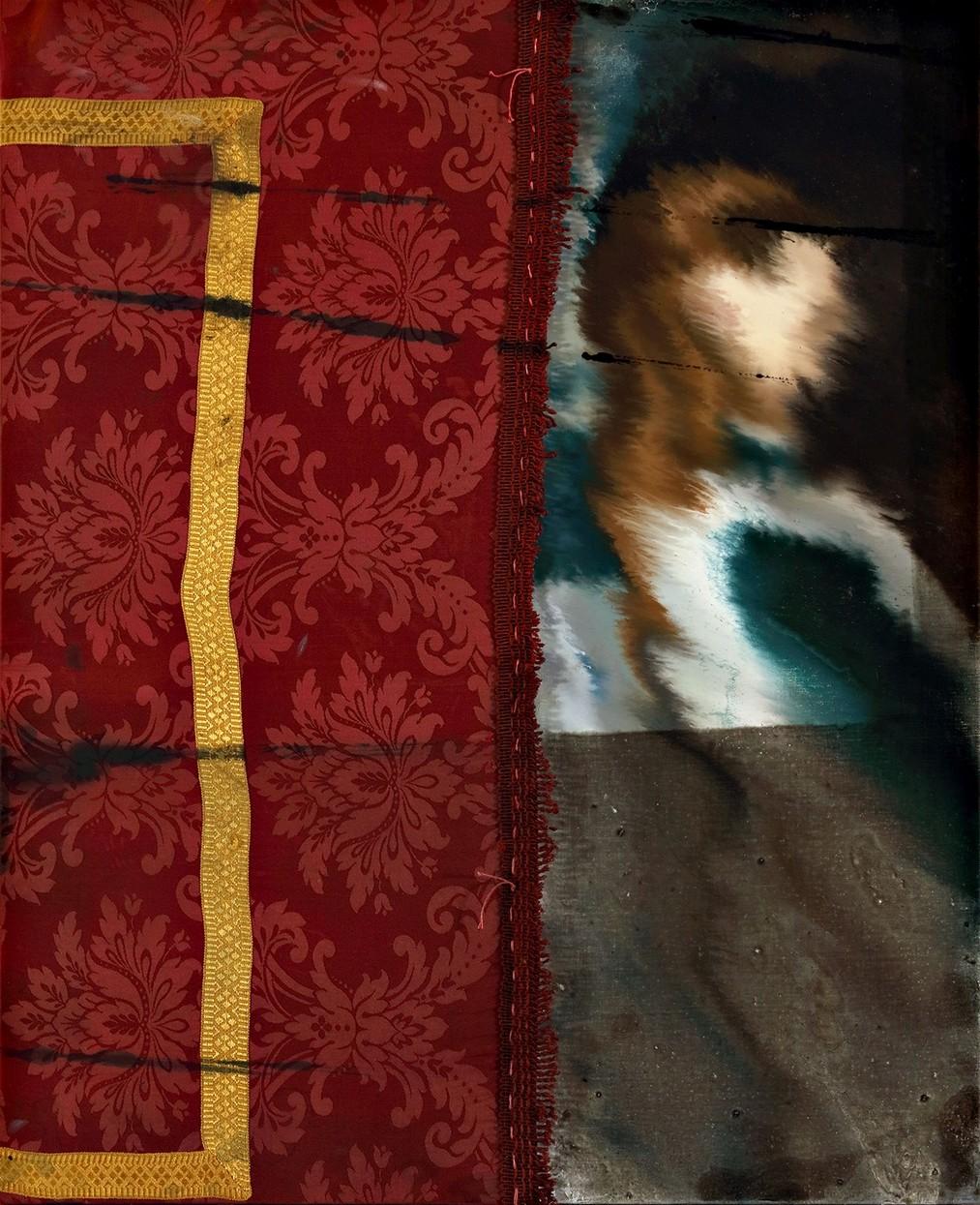
$6,500.
 Jorge R. Pombo, Spanish (b. 1973). Variation on Singer Sargent's 'The Daughters of Edward Darley Boit' (2), 2020. Oil on linen, 82 5/8 x 130 inches. $35,000.
Jorge R. Pombo, Spanish (b. 1973). Variation on Singer Sargent's 'The Daughters of Edward Darley Boit' (2), 2020. Oil on linen, 82 5/8 x 130 inches. $35,000.
Sol LeWitt, American (1928-2007). Distorted Cubes (A), 2001. Linocut, 28 x 36 in. Signed and numbered in pencil. $6,750.
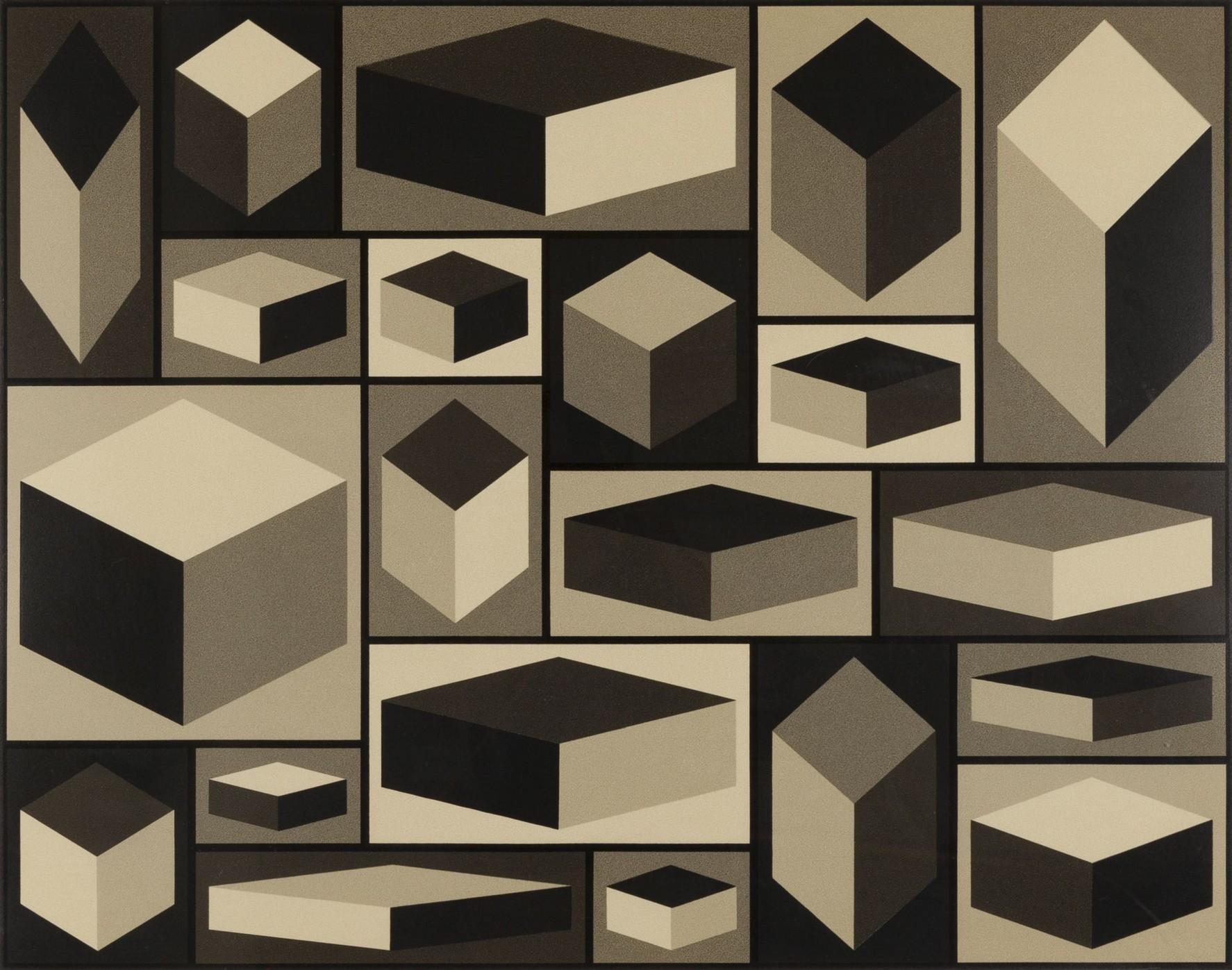
January 14 – February 5, 2022
Prints are produced by drawing or carving an image onto a printing surface (the matrix), such as a wood block, metal plate, or lithographic stone. This surface is then inked and the image is transferred to paper by the application of pressure, using either a printing press or various hand tools. The printmaking techniques on view Ink, Press, Repeat can be divided into four major categories: Relief, Intaglio, Planographic, and Stencil. Within these four categories exist a myriad of different printmaking techniques, each with its own unique combination of materials, tools, and processes.
In this exhibition, Childs Gallery staff selected some of their favorite representations of different printmaking techniques, including aquatint, collagraph, drypoint, engraving, etching, linocut, lithograph, mezzotint, monotype, screenprint, woodcut, and wood engraving, for a survey spanning the history of printmaking from the Renaissance to the present.
Featured artists included Frank Benson, Letterio Calapai, Catarina Coelho, Erik Desmazières, Sean Flood, Rockwell Kent, Sol LeWitt, Henry Moore, Rembrandt, Giovanni Battista Scultori, Carol Wax, James Abbott McNeill Whistler, and others.
Carol Wax, American (b.1953)
The Oliver, 2004 Color mezzotint, 18 x 18 inches Number 59 in an edition of 75. Signed in pencil.

$2,000.
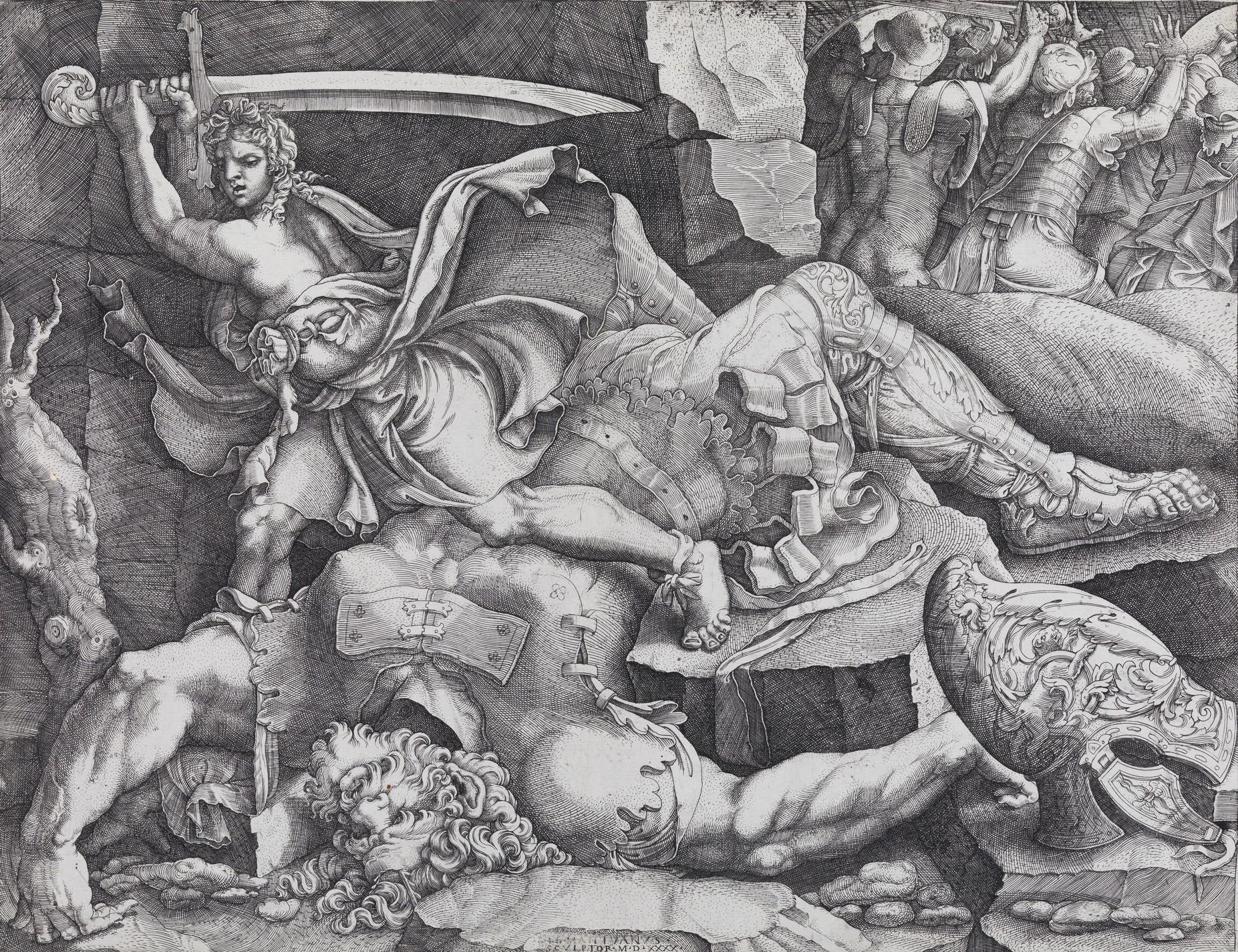
America’s Past-time presents a marked departure for Robert Freeman. Known for his celebratory images of the Black middle class, paintings from Freeman’s latest series delve into the deep racial divides within our country. Alarmed at the prominent deaths of several Black Americans at the hands of police, Freeman’s imagery pivoted as an expression of his anger, outrage, and sadness. The resulting works make up America’s Past-time, wherein adults play traditional children’s games, often to deadly ends.
Freeman states of his new work: “The deaths of George Floyd and Breonna Taylor exemplified what Black Americans already knew about their own history. This time a cellphone video secured a horrific event for the whole world to witness. All too soon after came January 6th where again the world observed how divisive and violent our racial politics are. On the eve of the first anniversary of the Capitol insurrection, my paintings represent the division that continues to rip at our nation's seams.”
Paintings in America’s Past-time take their titles from familiar children’s games or activities. Playing deadly versions of these games, Freeman’s Black figures are portrayed as violently losing to their counterparts. While the playful titles belie gruesome scenes, Freeman imparts his Black figures with a defiant dignity. They may be the “losers” of these games, but they are the heroes of Freeman’s paintings.
As visual metaphors of the racial divides in our country, the paintings in America’s Past-time are empowered by their blending of seeming innocence and apparent evil. Even the series title is a bit of clever name-play, referring both to fun, harmless leisure activities, as well as the brutal “pasttimes” faced by African Americans during slavery and the Jim Crow era. Freeman’s works are important and beautifully grim - warnings and a wakeup call for action towards social justice in our country.


Italian School, (19th Century) Colosseum Micromosaic Paperweight. Marble, 3 1/4 inches.

The oval micromosaic depicting the Colosseum, inlaid to a cartouche-form black base. $1,250.
February 17 – April 2, 2022
From the 17th to 19th century, wealthy young European men embarked on lengthy travels around the Continent to round out their education. These travels, known as the Grand Tour, emphasized Classical arts and architecture, languages, history, literature, and philosophy, through trips that could last anywhere from several months to several years. Grand tourists were typically upperclass Englishmen, and though there was no set itinerary, treks usually involved sojourns throughout France, Switzerland, and Italy, but could also include locations further afield.
During their journeys tourists would buy souvenirs, often art depicting local sights and wonders as well as objet d’art – bronze, alabaster, or marble reproductions of buildings and ruins by native craftsmen. Souvenirs of the Grand Tour brings together art and objects collected during these educational travels, as well as more modern and contemporary scenes of locations and monuments that would have been typical stops along the way.
The exhibition journeyed from the temples of Ancient Egypt to the ruins of the Roman forum, treating viewers to their own version of the Grand Tour through prints, watercolors, drawings, and small sculptures.
Italian School, 19th Century Model of the Façade of the Roman Senate. Bronze, 5 x 4 3/4 inches. With dark brown/black patina with areas of verdigris and mounted to rectangular base. $1,200.
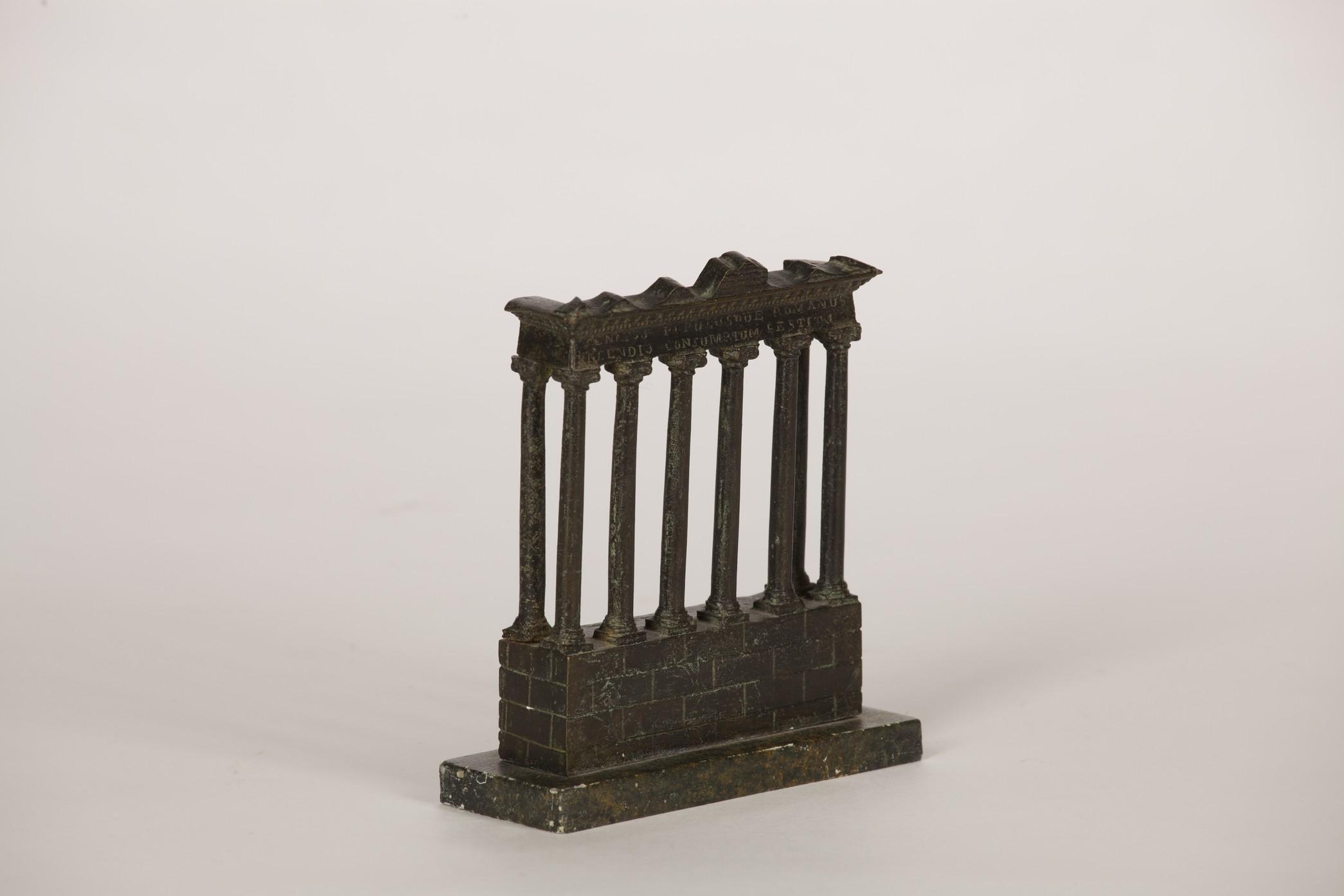
Italian School, 19th Century Black Figure Lekythos. Ceramic 4 3/4 inch height Grand Tour Lekythos depicting a male figure making an offering.
$300.
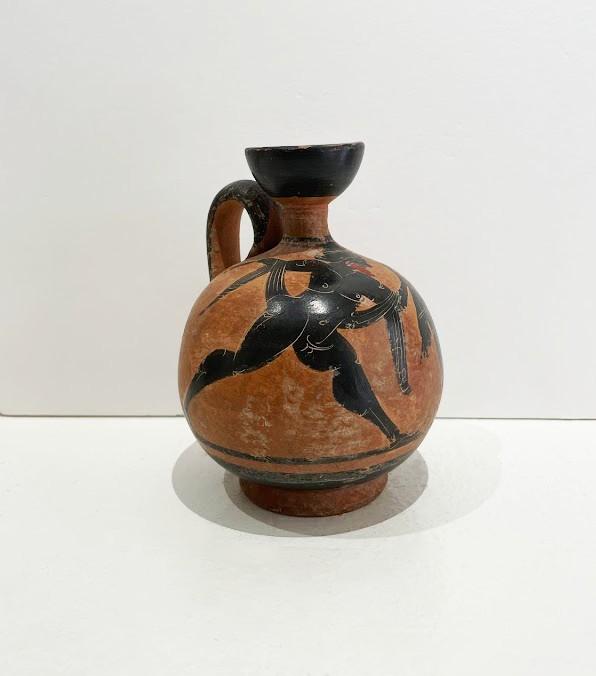
Urban Aesthetic, Sean Flood’s fourth solo exhibition at Childs Gallery, focused on scenes of New York and Boston, the two cities between which the artist splits his time. In a series of new paintings and prints, Flood explored these two metropolises through their cityscapes, transit systems, and people. With his distinctive layering and mark-making, Flood paints urban scenes in an expressive fashion that mimics actual construction practices, building an artwork, like a skyscraper, from the ground up.
Flood often works from life, painting on street corners and rooftops, and sketching on the subway. Capturing images in this fashion, the artist uncannily taps into the reverberating energy of city life, each brushstroke a distinctive mark enlivened with the spontaneity inherent in plein air work. This urban energy is integral to Flood’s work, as he strives to translate this palpable feeling into static form.
Flood also observes a city’s varied interactions, between buildings, streets, and people, through dynamic mark-making. His attention to the many synergies of urban life is particularly strong in paintings like Chandler Tremont Plaza, where Boston’s low brick buildings compete with modern skyscrapers, and his Passenger series, in which subway commuters variously interact with each other and their phones.
Flood’s paintings and prints serve as a record of the rapidly changing urban environment, lending his work an almost documentary quality. Viewed through the years, his body of work tracks the rise of new buildings, as well as the demolition of the old. For all their moving intensity, each of Flood’s works captures a definitive time and place. Each one offers a glimpse of the city, bottling the energy of a specific moment on paper or canvas.
Flood has for many years now integrated printmaking (primarily monotype) into his oeuvre. He continues to work fluidly between painting, printmaking, and drawing, paying particular attention to how atmosphere, texture, and mark-making come together throughout different media. Urban Aesthetic brought together examples of these different techniques, and presented an exhilarating and insightful journey through the streets of Boston and New York.
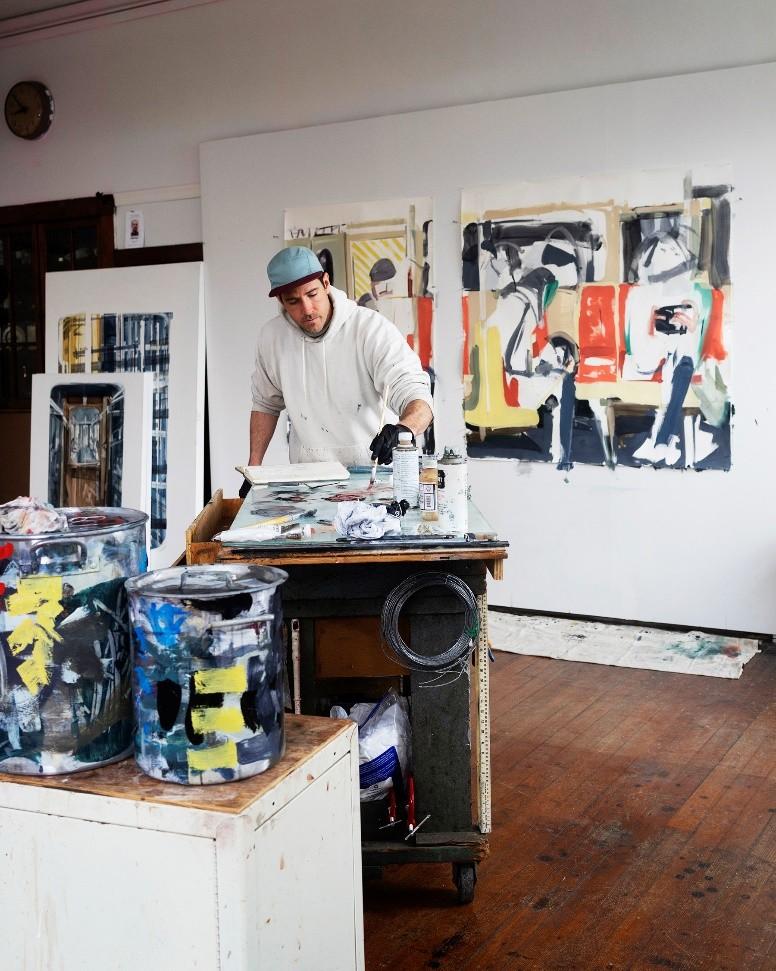 Photo by Jillian Freyer
Photo by Jillian Freyer
Sean Flood, American (b. 1983) Cave Studies, 2019 Monotype, 24 x 18 inches Signed lower right

$3,000.
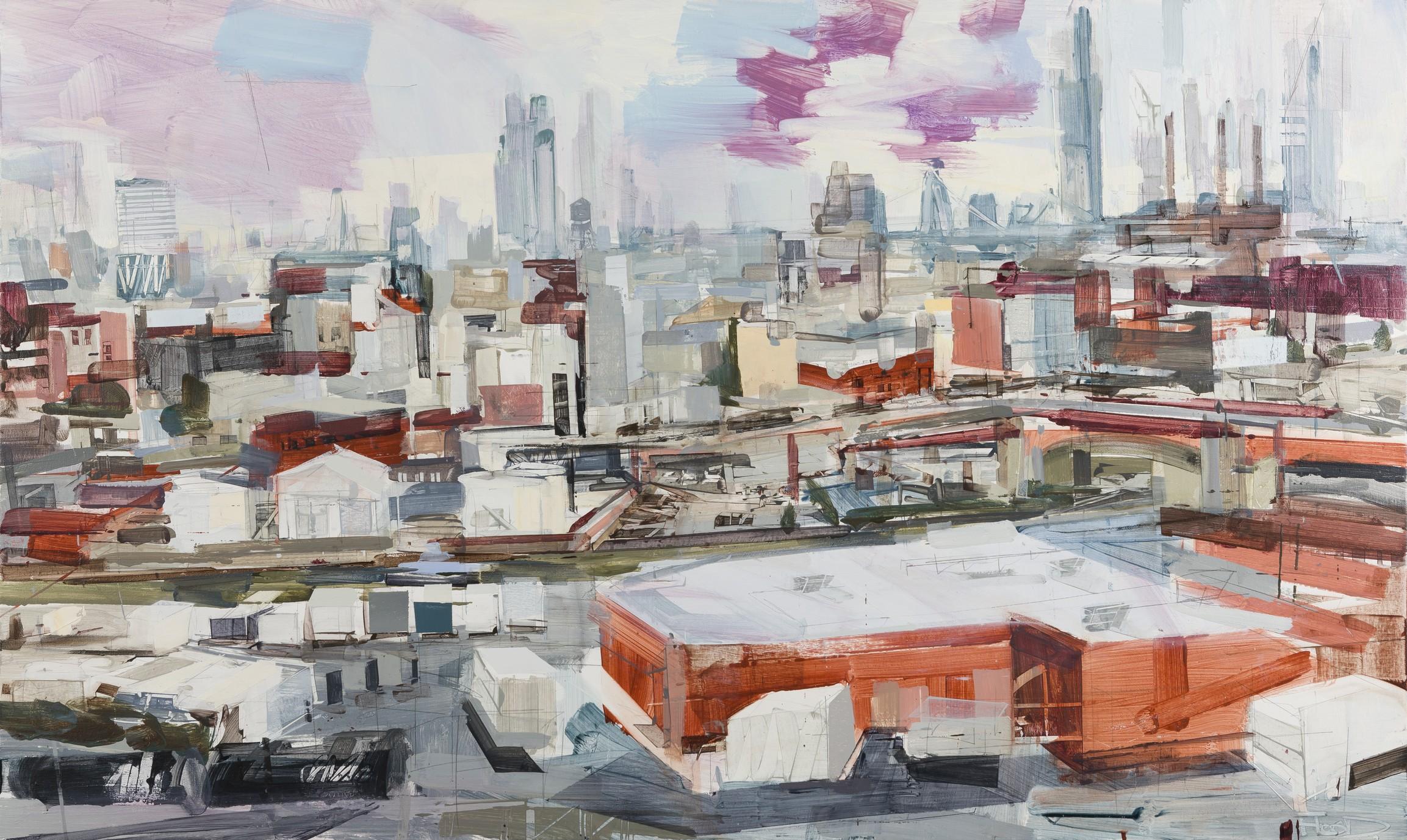 Sean Flood, American (b. 1983). Into Brooklyn, 2018. Oil on canvas, 36 x 60 inches. Signed lower right. $18,000.
Sean Flood, American (b. 1983). Into Brooklyn, 2018. Oil on canvas, 36 x 60 inches. Signed lower right. $18,000.
Adam Van Doren, American (b. 1962)
Colonial Williamsburg, 2021. Watercolor and graphite on paper, 21 x 15 1/2 inches. $3,500.
Adam Van Doren, American (b. 1962)
Nassau Hall, Princeton, 2021. Watercolor, gouache and graphite on Arches paper, 21 1/2 x 14 1/2 inches. $3,500.
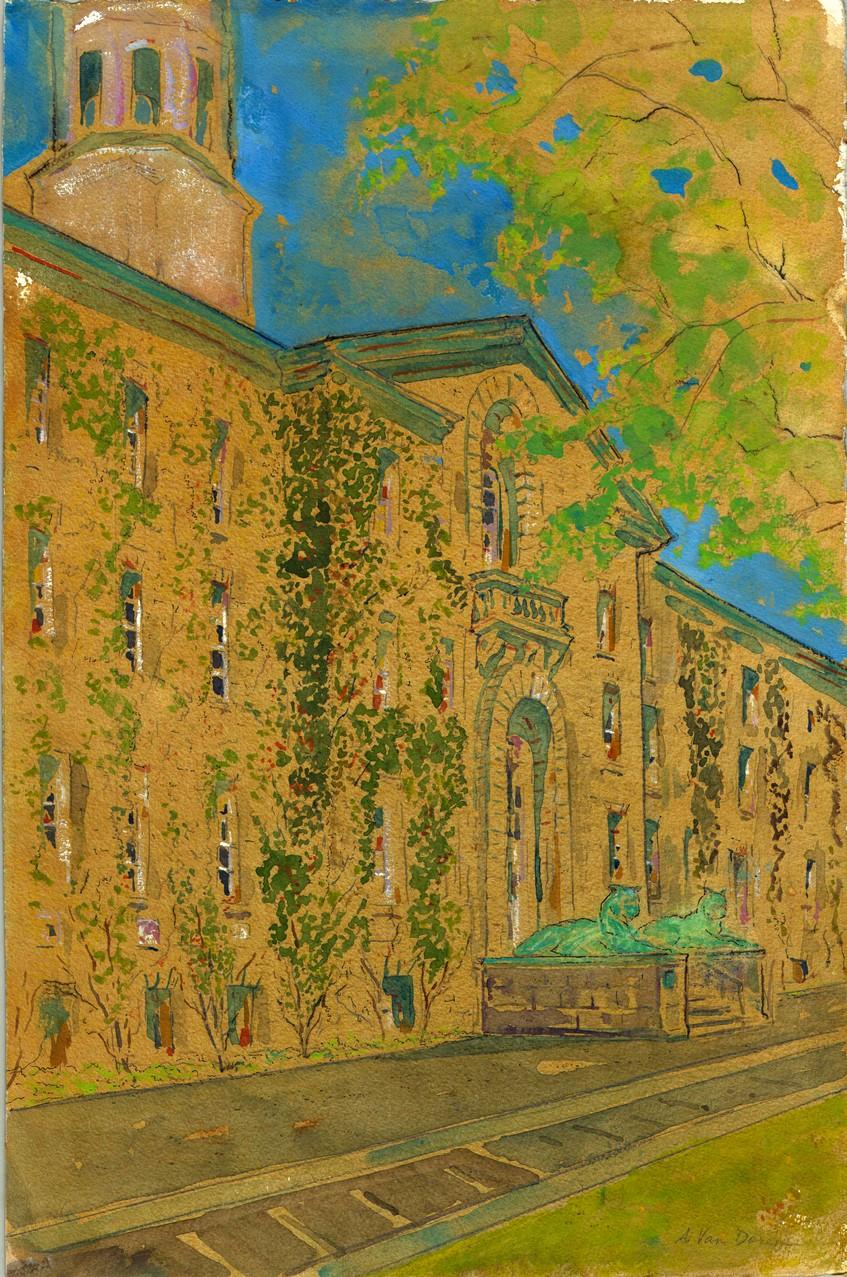
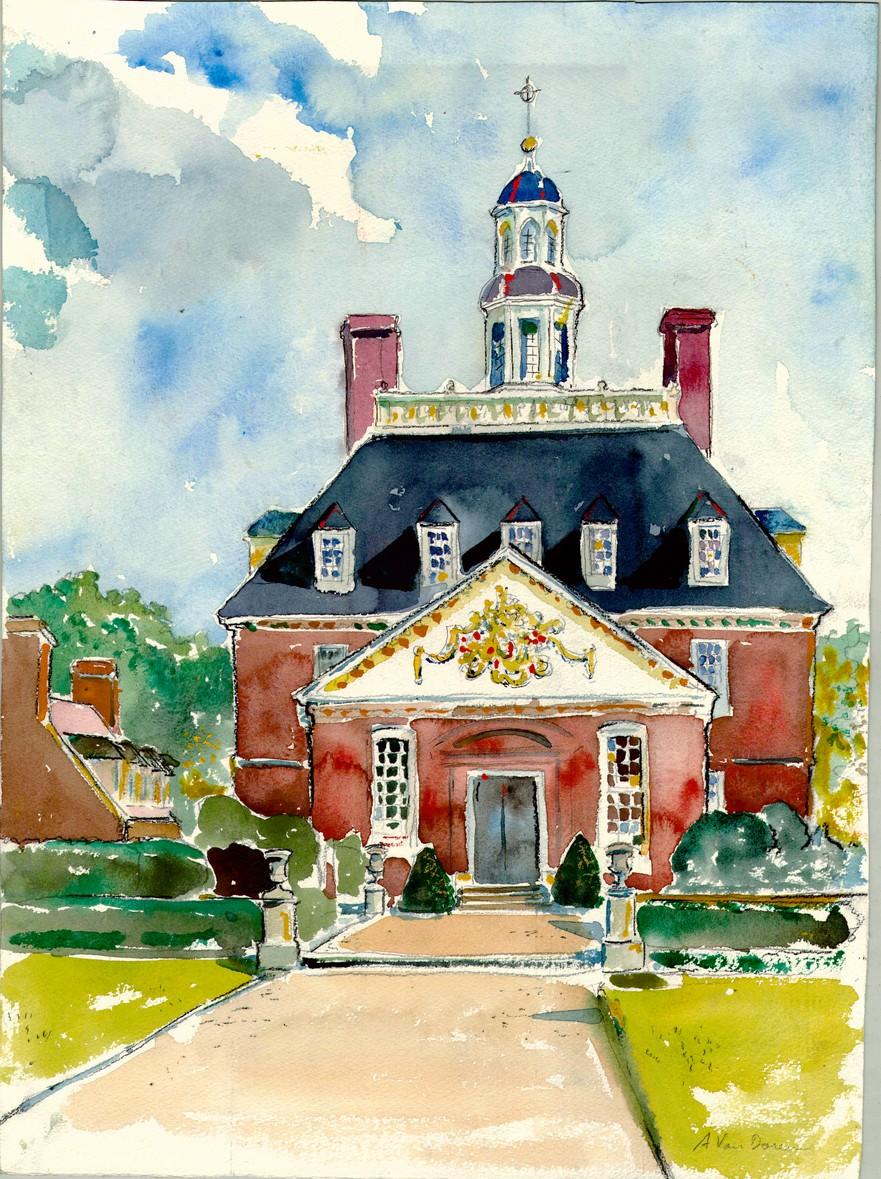
Featuring artwork from Van Doren’s latest book, In the Founders’ Footsteps: Landmarks of the American Revolution, the exhibition was a journey through history, touring sites associated with the Revolutionary War and America's founding.
From well-known buildings and monuments to more obscure niches throughout the original thirteen colonies, Van Doren’s watercolors document America’s early cultural landscape. Sites visited include Philadelphia’s Independence Hall, Yorktown battlefield and Colonial Williamsburg in Virginia, Fraunces Tavern in New York, and the Joseph Webb House in Connecticut, among others.
In his vibrantly expressionist style, Van Doren explored where the Founding Fathers lived, fought, and died in pursuit of independence, offering an insightful tour of Americana and early history of the country.
May 19 – July 9, 2022
After the heaviness of the past several years, Blatman’s exhibition focused on the optimistic ideologies associated with the arrival of springtime. Renewal and revitalization are represented through dandelions and clouds highlighted with golds, bronzes, and sparkling glitter – ephemeral objects grounded in more permanent materials. Musing on love, nature, the universe, and death, Blatman’s paintings, drawings, and installations in Pure Love were a visual reawakening after darkness.
Fond memories from Blatman’s childhood are embedded into her new work, revealing themselves through the artist’s style and aesthetic choices. Her father was a master upholsterer whose material room full of differing textiles provided an ample playground for a young Blatman. Her interest in varying materials and textures manifests in the use of diverse media such as oils, colored pencils, gold leaf, and glitter, on unusual substrates like mylar and aluminum panels.
Since contracting Covid in March 2021 and again in April of 2022, Blatman has contemplated the relationship between humanity and all existence - life on Earth, the clouds, the stars, the universe – building a body of work reflecting ideas of interconnectedness and impermanence. After a hospitalization during her first bout of Covid, Blatman returned to her work with a sense of renewal and hope – somber black backgrounds turned to glittering gold, and fluffy dandelions and clouds began to appear in her paintings.
These soft, mutable, ephemeral objects speak to the brevity of life, the inevitability of death, and the integral connection between the two. Yet Blatman isn’t just interested in beginnings and endings – she also considers what happens during the in-between. The happiness, the turmoil, and myriad of other states we experience during our time on Earth; humans, like the objects in her paintings, are ever changing. These works are in effect, radiant, sparkly memento mori –reminders of our frailty but also to enjoy ourselves, as time is ultimately fleeting. Blatman has challenged herself to tackle overwhelming subjects and morph them convincingly into tragically beautiful works of art.
Though her work may confront daunting ideas, Blatman states that the paintings, drawings, and installations in Pure Love: Stardust, Clouds and Dandelions come from a place of love and gratitude and hopes to offer viewers a feeling of grace as vast as the universe.

Resa Blatman, American Reverie, 2022
Oil, acrylic, gold leaf, and glitter on aluminum panel mounted on wood, 60 x 40 inches $20,000.


Dandelions with Stormy Skies #1, 2022 Oil on mylar, 24 x 18 inches
$4,500.
 Resa Blatman, American. Space Clouds #3, 2021. Oil, acrylic, and glitter on aluminum panel, 20 x 30 inches. $5,000.
Resa Blatman, American. Space Clouds #3, 2021. Oil, acrylic, and glitter on aluminum panel, 20 x 30 inches. $5,000.
E. Lombardo’s series, Soft Butch Blues, explores the artist and her wife’s journey to parenthood. The series of fourteen drypoint prints documents the intimate process from trigger shots to birth to acclimating as a family of three. Addressing reproductive rights, body autonomy, fear, anxiety, and more, Soft Butch Blues navigates difficult subjects with joy, warmth, and refreshing frankness.
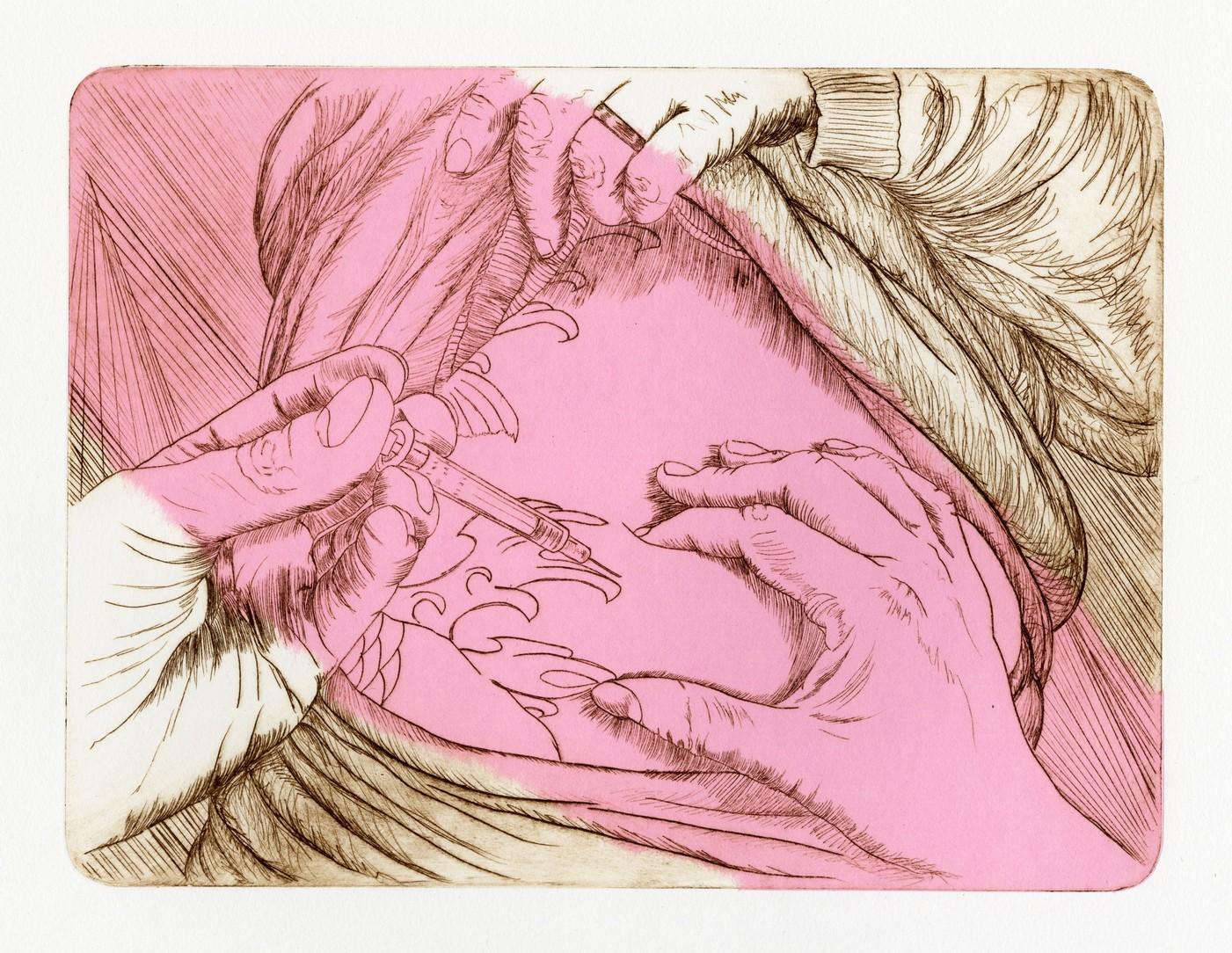
The prints are an autobiographical resistance against society’s tendency towards lesbian erasure. They record both the extraordinary and mundane events associated with birth and parenthood through a lesbian-centric lens, capturing a unique yet familiar perspective on family. Executed in fine intricate colorful lines on varied papers, the prints in Soft Butch Blues display the exuberance, worry, and fragility of the family’s experience.
The completion of the Soft Butch Blues series and its exhibition at Childs Gallery came at a tumultuous time within the United States, as the country witnessed the unfolding of a dangerous reversal in equality and human rights. In this environment, the amplification of queer narratives is crucial.
Lombardo prescient statement on the project, mere weeks before news broke on the landmark court case reads: “As the Supreme Court is considering reversing Roe vs. Wade, this work is about motherhood, the most complex choice a person can make about their body. More than a dozen states are legislating ‘Don’t Say Gay’ bills which threaten the rights of LGBTQ+ adults, children, and families to discuss their lived experience openly just as any heteronormative person can. Soft Butch Blues is a story of enduring love and blind faith as everything seems to be teetering on the edge.”
Emily Lombardo, American (b.1977) Trigger, 2022 Drypoint with chine-collé, 9 x 12 inches Signed verso.
$1,050.
Heaven is a Place on Earth, 2022 Drypoint with chine-collé, 10 1/2 x 8 inches Numbered, titled, signed, and dated verso: "EV 5/10 "Heaven is a Place on Earth" Lombardo 2022".
$1,050.
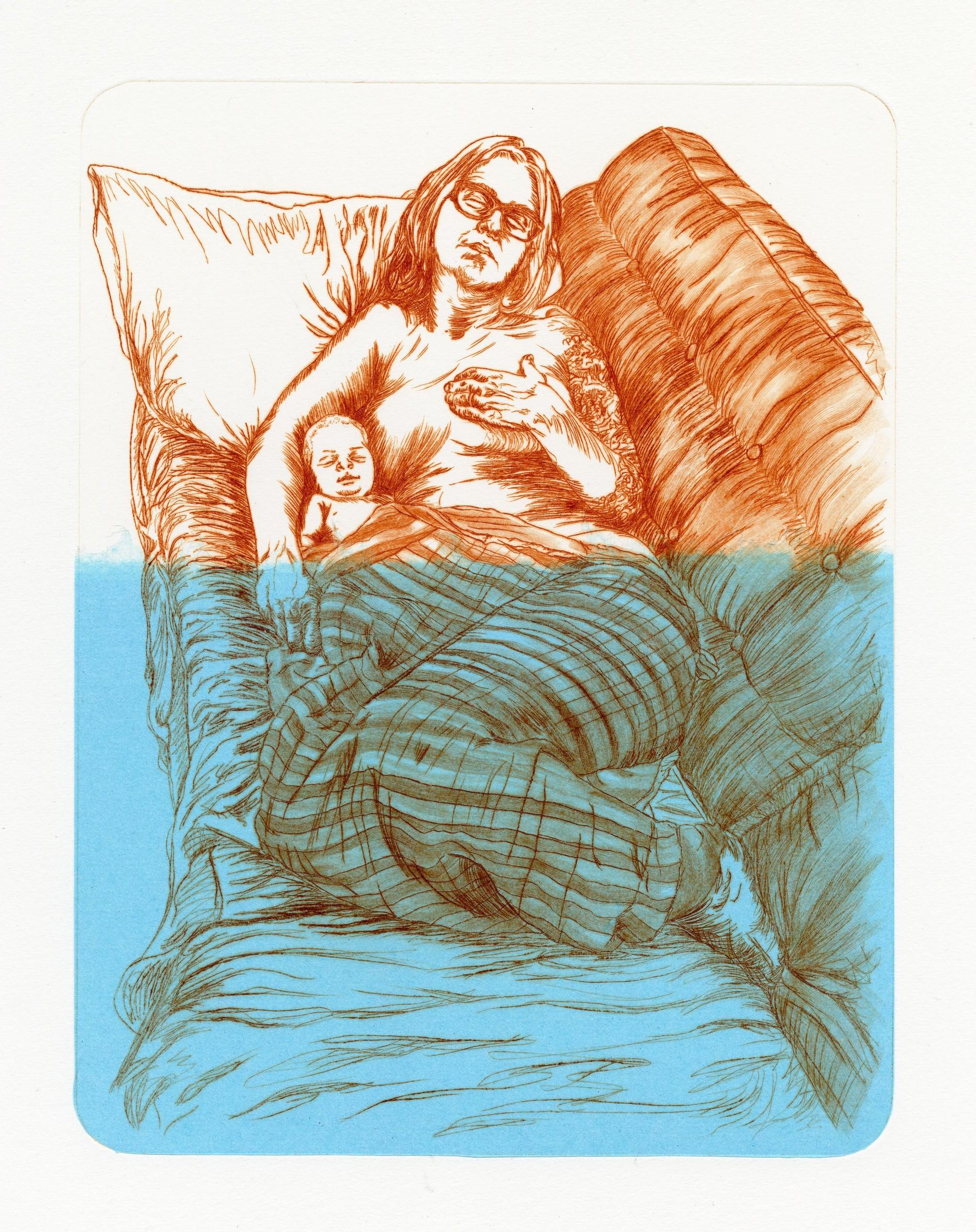
July 14 – September 10, 2022
This exhibition brought together paintings, prints, drawings, photographs, and sculpture from historic and contemporary artists celebrating the beauty of animals both domesticated and wild.
The human fascination with animals and the desire to encapsulate them in art begins in prehistory, when the earliest artists painted wild game on rocks and caves in simplified forms that communicated an intimate knowledge of the creatures providing food, clothing, and other necessities. Since then, animals have continued to loom large within the art historical cannon, appearing throughout the centuries variously as religious symbols, scientific interests, prize-winning beasts, and beloved companion pets.
Beauty in the Beasts pulled from these many animal-centric genres with pieces spanning from the 19th to 21st centuries. Contemporary artists including Nancy Anderson, Amy Ross, and Karen Lee Sobol explore the breadth of the animal kingdom, from the pampered life of domesticated dogs to the untamed spirit of wild animals and the alien creatures inhabiting our embattled oceans.
Works by historic artists included soulful elephant lithographs by Henry Moore, a farmland scene with hens from Herbert Barnett, charming photographs of a scruffy black poodle and its owner by George Platt Lynes, and Clifton Tomson’s stunning sporting portrait of Altisidora, a 19 th century thoroughbred racehorse.
The exhibition additionally featured work by Resa Blatman, Donald De Lue, Erik Desmazières, Walton Ford, Sawool Kim, Molly Luce, Anne Lyman Powers, Dudley Vaill Talcott, Carol Wax, and others.
The exhibition was organized in part to help recognize the important work done by the MSPCA (Massachusetts Society for the Prevention of Cruelty to Animals). The organization tirelessly advocates for the welfare of animals through adoption, low cost spay and neuter clinics, community outreach, and other programs. A percentage of the proceeds from Beauty in the Beasts will benefit the MSPCA, to assist in their ongoing efforts to promote and preserve the human-animal bond through socially conscious rescue, sheltering, and adoption.
Gallery Director and longtime MSPCA volunteer Kathryn Fields stated, “We’re all animal lovers at Childs Gallery. We frequently bring our dogs to work and welcome others who come in with their owners. Animal advocacy is therefore incredibly important to us, and we hope this exhibition, celebrating the varied beauty of the animal kingdom, inspires the same feeling of compassion in others. We put together Beauty in the Beasts as a showcase for the extraordinary breadth in point of view when considering animals as subjects of art, and in hopes of contributing to the MSPCA’s work in animal welfare.”
Walton Ford, American (b. 1960). Condemned, 2007. Etching, aquatint and drypoint, 12 x 9 inches. $10,500.


Dudley Vaill Talcott, American (1899-1986). Goats Nursing, 1938. Bronze, 5 1/2 x 5 1/4 x 3 1/4 inches. $4,500.
 Clifton Tomson, British (1775-1828). Mr. Watt's Altisidora, Winner of the 1813 St. Leger. Oil on canvas, 39 3/8 x 49 7/8 inches. $42,000.
Clifton Tomson, British (1775-1828). Mr. Watt's Altisidora, Winner of the 1813 St. Leger. Oil on canvas, 39 3/8 x 49 7/8 inches. $42,000.

American abstract artist Robert S. Neuman’s career spanned more than six decades and stretched geographically from his birthplace of Idaho to the San Francisco Bay Area to coastal Maine. Though mostly known for his colorful, energetic paintings, Neuman was also prolific in printmaking and mixed media. Robert S. Neuman: Works on Paper presented various prints and other paper-based artworks from the artist’s long career, showcasing his adept talent at translating his visions across multiple different media.
Neuman embraced the tenets of modernism early in his career and devoted his life to an exploration of its visual essentials — an exploration infused with abstract, symbolic and occasionally overt references to places and people familiar to the artist. As Neuman worked in series that would span decades, his body of work defies the traditional expectations of artistic trajectory and development. Using shapes, symbols, and calligraphy, Neuman created a specific reoccurring visual language in each of his series that tie the pieces together across his lengthy career. Robert S. Neuman: Works on Paper included works from many of Neuman’s best known series including Alhambra, Lame Deer, Ship to Paradise, Space Signs, and Voyages.
The exhibition also celebrated the release of Pieces of the World: The Art and Life of Robert S. Neuman, a new documentary which gathers in-person interviews with scholars, family, and friends, archival and personal photographs, and images of numerous artworks to create an intimate and compelling portrait of the artist.
Robert S. Neuman, American (1926-2015)
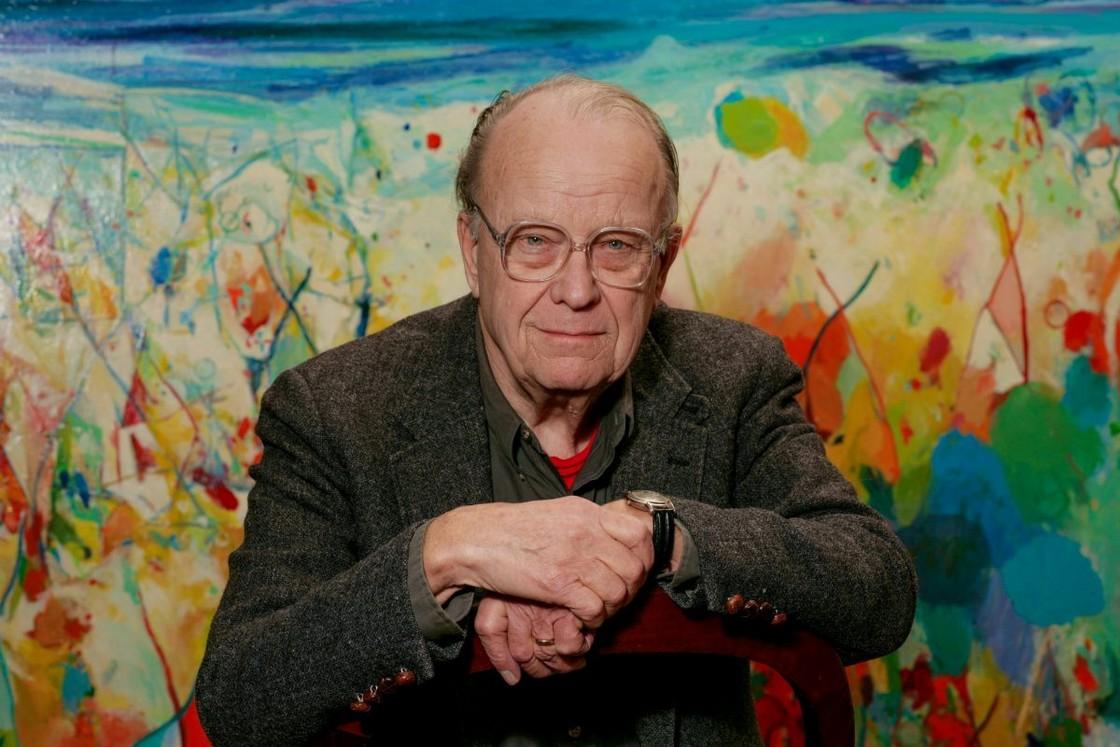
Tower for Dreams and Other Events, 1972
Mixed media on paper, 39 1/2 x 27 1/2 inches. $15,000.
Photograph by Clive Russ, 2000 Courtesy Sunne Savage Gallery
 Robert S. Neuman, American (1926-2015). Pedazos del Mundo Study, 1963. Mixed media collage, 22 1/4 x 30 1/4 inches. Initialed and dated lower left: "RSN / 1963". $15,000.
Robert S. Neuman, American (1926-2015). Mirage Study - 6, 1966 Mixed media on paper, 10 1/4 X 16 1/2 inches. Initialed and dated lower left: "RSN / 1966”. $7,500.
Robert S. Neuman, American (1926-2015). Pedazos del Mundo Study, 1963. Mixed media collage, 22 1/4 x 30 1/4 inches. Initialed and dated lower left: "RSN / 1963". $15,000.
Robert S. Neuman, American (1926-2015). Mirage Study - 6, 1966 Mixed media on paper, 10 1/4 X 16 1/2 inches. Initialed and dated lower left: "RSN / 1966”. $7,500.
September 15 – November 12, 2022
In this exhibition, Hall’s mixed media sculptures and installations were inspired by her climate change advocacy and recent personal crisis, building a story explored through cause and effect, control and surrender, love and loss.
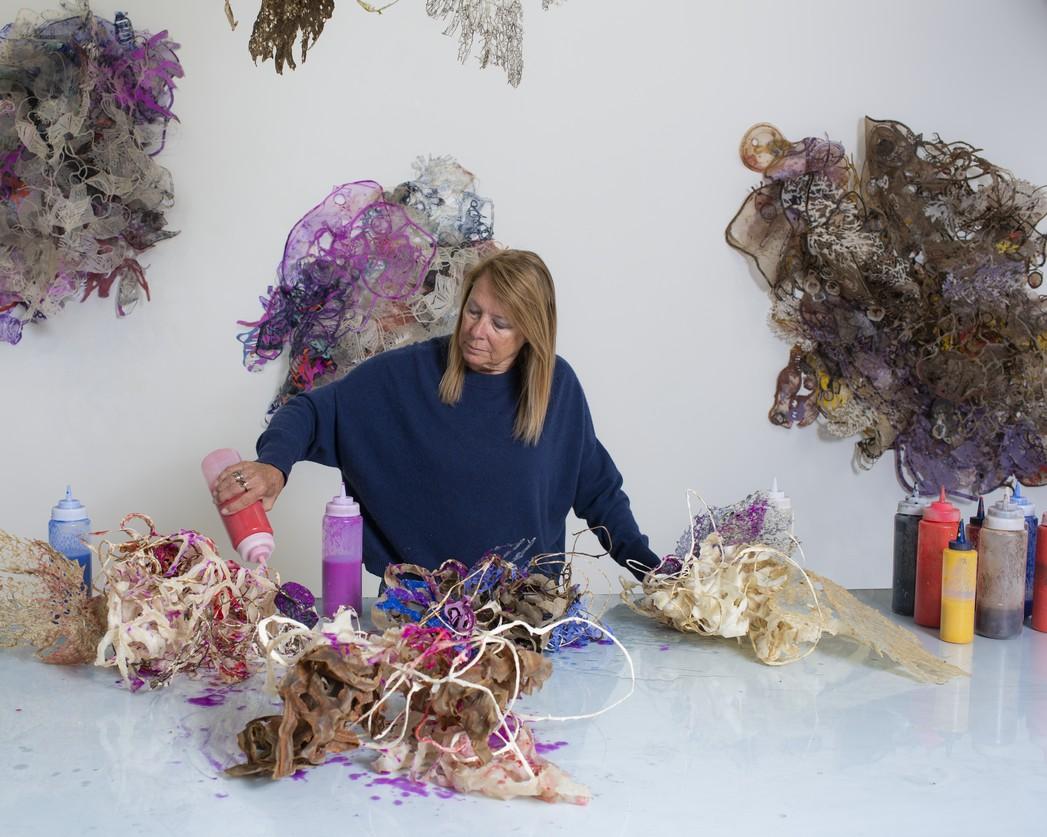
Hall’s large-scale sculptural works emphasize the materials of handmade paper, glass, and metal, and address her deep connection to and concern for the Earth’s oceans. A lifelong sailor, Hall uses her art to promote marine advocacy, primarily concerning the human impact on water quality. From her home and studio in Jamestown, Rhode Island, Hall sees the effects of climate change firsthand – the increasing plastic pollution infesting waterways, the appearance of invasive algae, and the subsequent loss of native aquatic species, all of which disrupt delicate and vital ecosystems.
Hall confronts these threats head-on, incorporating plastics and assorted trash found on local beaches into collagraph printing plates which impress haunting images of human waste onto handmade paper. Hall also uses vibrant pigments, often in the form of pulp, to color her pieces in hues that mimic destructive algae found propagating in non-native waters. Her handmade papers are sculpted into undulating wave-like forms that are a beautiful but cautionary reminder of humankind’s role in widespread oceanic pollution. Ultimately, Hall’s goal is to initiate a conversation about the deterioration of our greatest resource – water, in the hope that her message yields positive change.
While the immersive works in Where Light Dances expressed Hall’s despair and hope concerning climate change, they also addressed recent personal grief after the loss of her husband, art historian Mark S. Weil. The exhibition connects global catastrophe and personal tragedy through works that resonate with both the artist and audience. Ocean Library is a sculpture constructed from paper and sand, cast to resemble stacked books – Hall made the paper from Weil’s cotton shirts and silk ties, and the sand was collected from beaches the world over. The piece comments on the finite nature of sand but also speaks to our limited time with loved ones. Sand and time slip through our fingers so quickly; they are fleeting and should be appreciated, treasured, and protected while able. The cast books are records of events past, both from a global perspective and Hall’s own experiences.
The exhibition title, Where Light Dances, is taken from Victoria Finlay’s book Color: A Natural History of the Palette, referencing a passage detailing the author’s childhood visit to Chartres Cathedral and the dazzling impression of its vivid stained glass. Hall’s work similarly utilizes color and memory to craft a story global in scale and human in feeling, tackling ubiquitous truths and private hardships. Where Light Dances weaves together hope for the future health of our oceans and optimism in the face of private grief, through Hall’s organic and engaging paper forms.
Photo by George BouretJoan Hall, American Love, Loss, Serenity, 2022
Handmade paper, pulp painting, collagraph, acrylic, mylar, handcut construction, 60 x 65 x 6 inches.
$16,000.
Joan Hall, American Ocean Library, Stack 3, 2022
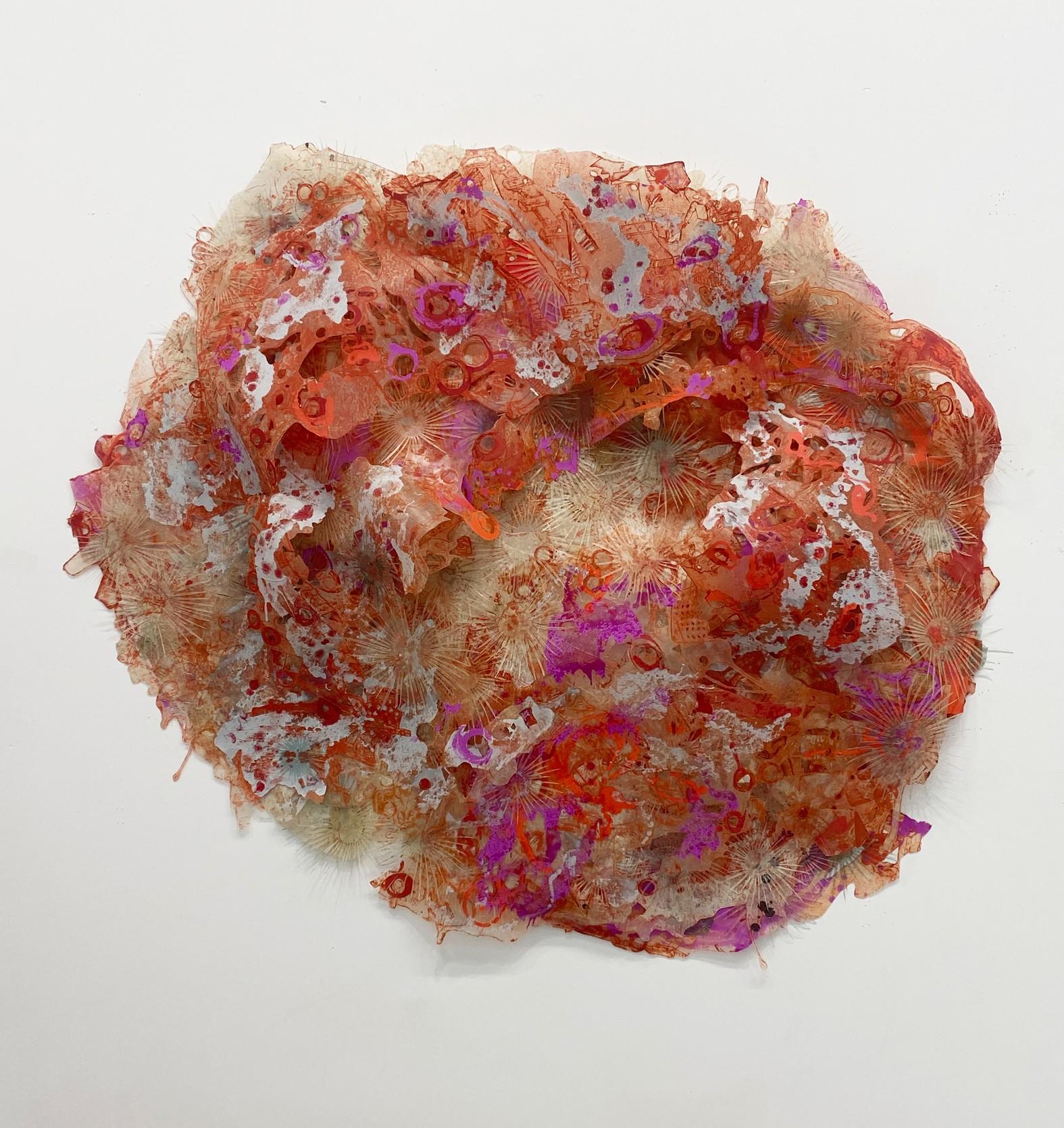
Cast handmade paper, silk ties, plastic detritus, sand from beaches around the world, rose petals, beach glass, resin. 11 1/2 x 17 x 15 1/2 inches. Signed on 4th book down.
$12,500.
The Ocean Library stacks incorporate physical and emotional reminders of Hall’s husband, Mark S. Weil, while also reflecting upon environmental issues. The cast paper books are made from Weil’s cotton shirts and silk ties and coated with sand collected from beaches around the world. The paper books sit atop a cast resin book base embedded with plastic detritus and beach glass.
Each stack contains casts of two books: one belonging to the artist, History of Art by H.W. Janson, and one belonging to her husband, a history of religious art written in French. Janson’s textbook, which Hall read as a freshman in art school, does not include a single woman artist – it is a book of misinformation. In creating this work, Hall was thinking about the spread of misinformation surrounding the climate crisis, as well as the sense that attempts to reverse climate change can feel akin to religion – acts of faith wherein the result is not always evident.
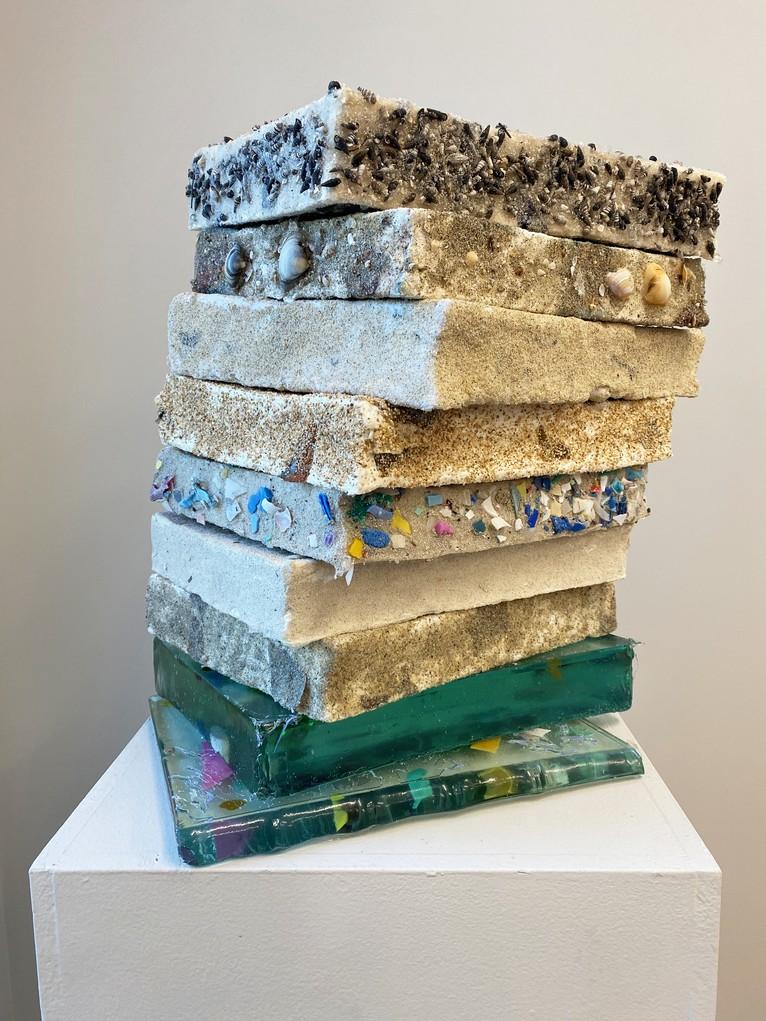
October 6 – December 30, 2022
William Evertson’s latest series of woodblock prints drew inspiration from the idea of fake news, disinformation, propaganda, and the construction of divisive narratives that drive culture wars. The works in Politics, Protest, History, and Myth layer culturally resonant imagery upon overlapping themes from both our national and global history and mythos, examining the nature of shared ideas in a climate of extreme politicization. The woodblock printing method provides a bold, graphic media through which the artist seeks to understand the structure of both past and present. Combining historical research with old printing technology to comment on new but recurring issues, Evertson lays bare pervasive societal flaws that cross time and culture.
Born in 1952, Evertson grew up with drills hiding under desks in preparation for nuclear war – a precursor to today’s active shooter drills. While a twenty-something artist, America’s landscape of cultural and political upheaval - including the assassinations of Martin Luther King, Jr. and Robert F. Kennedy, anti-war protests, Black Panthers, the Chicago Seven, and Kent State massacre –helped foment Evertson’s passion for activist art.
The prints in Politics, Protest, History, and Myth continue Evertson’s interest in asserting political activism through visual media. Using collaged imagery, often blending art historical and printmaking allusions with modern references gleaned from the internet and television, Evertson creates familiar yet irreverent scenes packed with biting socio-political commentary, allowing an examination of current polarizing rhetoric through historic counterpoints. The effect is humorous, but also (and more importantly) contemplative, as the prints detail an account of the frightening, yet somehow buffoonish possible downfall of contemporary western democracy.
Evertson additionally pulls from Roland Barthes’ Mythologies, Guy Debord’s The Society of the Spectacle, and surrealist author René Daumal’s Mount Analogue for inspiration in his choice of imagery and narrative. Drawing upon these writings’ various philosophies, allegories, and semiotics, the artist explores a visual representation of the indifference towards and normalization of extremist viewpoints. Of particular interest in Evertson’s most recent work is the transformation of the Republican party’s platform - from the traditional obstruction of progressive ideas into MAGA’s theocratic authoritarian inclinations. The artist examines the subtle relationship of constructing mythologies as a propaganda technique, begetting the circulation of disinformation, to the advantage of the powerful and detriment of the masses. Evertson’s use of prints – a traditionally more proletariat artform – is a clever subversion of this, establishing his own iconography within editioned works to counteract widespread falsehoods.

 William Evertson, American. None So Blind, 2021. Woodblock print, 32 x 44 inches. Numbered and signed. Edition of 10 plus 2 artist proofs from four carved blocks. $3,000.
William Evertson, American Consumed by the Never Was, 2022. Woodblock print, 32 x 44 inches. Numbered and signed. Edition of 10 with 4 artist proofs. $2,500.
William Evertson, American. None So Blind, 2021. Woodblock print, 32 x 44 inches. Numbered and signed. Edition of 10 plus 2 artist proofs from four carved blocks. $3,000.
William Evertson, American Consumed by the Never Was, 2022. Woodblock print, 32 x 44 inches. Numbered and signed. Edition of 10 with 4 artist proofs. $2,500.
November 19, 2022 – January 7, 2023
Legendary Diva celebrated the art and life of the late Margaret Rose Vendryes – visual artist, art historian, curator, and dear friend of Childs Gallery. The exhibition showcased Vendryes’ prolific African Diva Project, a series of paintings, prints, and works on paper exploring race and gender. The project features iconic images of Black female music legends wearing traditional African masks. Spanning nearly two decades, the project was ongoing until Vendryes’ death in early 2022. The following is a description of the project in Vendryes’ own words:
The Project is informed by my engagement with African aesthetics and popular African American music and visual culture. What began as a painting series conceived to celebrate and connect popular Black women singers with their African ancestors has evolved. The most recent works are mixed media that include original masks, carved or cast, by African craftsmen.
African masks are worn almost exclusively by male performers and all are made exclusively by men. Ironically, most African masks represent women ancestors or spirits that transform the masked man during important times in a community’s life. African masking traditions offer rich ground for investigations of gender dynamics in the African Diaspora.
My African Divas break the rules by not simply wearing the mask but becoming the powerful being it represents. Like a singer taking the stage stimulated by a swell of music, the appearance of a masked performer transforms and elevates time and place. Although masquerades staged for entertainment have come to dominate the practice in Africa, performances are rarely meant to only entertain. There are lessons to be learned and stories to be transmitted in an effort to retain tradition and make a difference in the lives of the audience. Such is the case with all Black performers who are, and have always been, change agents.
The African Diva Project opens a dialogue about the power dynamics surrounding race and gender identity in the US. Early black female singers in the West were styled and marketed by white males in the record industry. What they wore, what they sang, and how PR machines presented them to the public was out of the performers’ control. An African Diva has agency and authority made possible, in part, by her potent African mask.
My craft is inspired, and instructed, by master portrait painters: John Singer Sargent and Barkley Hendricks among them. Hendricks, in particular, used the state portrait once reserved for wealthy whites to celebrate black beauty. I follow his lead with reverential, full-body portraits of black women soloists that are modeled on images designed to sell product. Becoming an African Diva dismantles the façade to unveil a true, ancestral aura.
I believe that the ability to perform well before live audiences is in one's DNA. As an African American art historian and artist, my work naturally relates to the African Diaspora. I am inside The African Diva Project with my handwritten inscriptions of titles and lyrics in the background that speak aptly for women whose ancestors might well have been African masqueraders.
Margaret Rose Vendryes, American (1955-2022). Igbo Billy, African Diva, 2020. Oil with cold wax on canvas, wood mask, 40 x 52 inches. Featuring Billy Porter. $24,000.
Margaret Rose Vendryes, American (1955-2022) Dan Solange, African Diva, 2019

Oil with cold wax on canvas, wood mask, synthetic hair, 30 x 12 x 2 1/2 inches. Featuring Solange Knowles. $6,500.

